
Remembrance Day is a memorial day observed in Commonwealth member states since the end of the First World War in 1919 to honour armed forces members who have died in the line of duty. The day is also marked by war remembrances in several other non-Commonwealth countries. In most countries, Remembrance Day is observed on 11 November to recall the end of First World War hostilities. Hostilities formally ended "at the 11th hour of the 11th day of the 11th month" of 1918, in accordance with the armistice signed by representatives of Germany and the Entente between 5:12 and 5:20 that morning. The First World War officially ended with the signing of the Treaty of Versailles on 28 June 1919.

"In Flanders Fields" is a war poem in the form of a rondeau, written during the First World War by Canadian physician Lieutenant-Colonel John McCrae. He was inspired to write it on May 3, 1915, after presiding over the funeral of friend and fellow soldier Lieutenant Alexis Helmer, who died in the Second Battle of Ypres. According to legend, fellow soldiers retrieved the poem after McCrae, initially dissatisfied with his work, discarded it. "In Flanders Fields" was first published on December 8 of that year in the London magazine Punch. Flanders Fields is a common English name of the World War I battlefields in Belgium and France.

The national flag of France is a tricolour featuring three vertical bands coloured blue, white, and red. It is known to English speakers as the Tricolour, although the flag of Ireland and others are also so known. The design was adopted after the French Revolution, where the revolutionaries were influenced by the horizontally striped red-white-blue flag of the Netherlands. While not the first tricolour, it became one of the most influential flags in history. The tricolour scheme was later adopted by many other nations in Europe and elsewhere, and, according to the Encyclopædia Britannica has historically stood "in symbolic opposition to the autocratic and clericalist royal standards of the past".
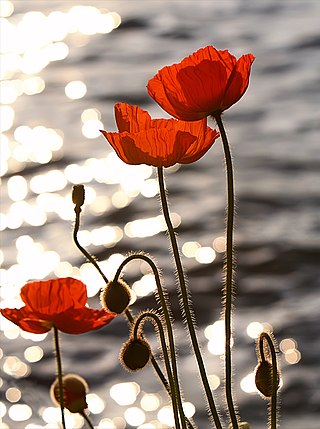
A poppy is a flowering plant in the subfamily Papaveroideae of the family Papaveraceae. Poppies are herbaceous plants, often grown for their colourful flowers. One species of poppy, Papaver somniferum, is the source of the narcotic drug mixture opium which contains powerful medicinal alkaloids such as morphine and has been used since ancient times as an analgesic and narcotic medicinal and recreational drug. It also produces edible seeds. Following the trench warfare in the poppy fields of Flanders, Belgium during World War I, poppies have become a symbol of remembrance of soldiers who have died during wartime, especially in the UK, Canada, Australia, New Zealand and other Commonwealth realms.
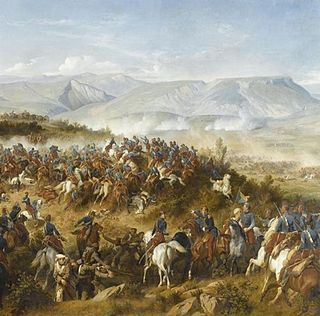
The Chasseurs d'Afrique were a light cavalry corps of chasseurs in the French Armée d'Afrique. First raised in 1831 from regular French cavalry posted to Algeria, they numbered five regiments by World War II. For most of their history they were recruited from either French volunteers or French settlers in North Africa doing their military service. As such they were the mounted equivalent of the French Zouave infantry. The other major cavalry element in the Armee d'Afrique were the Spahis—recruited from the indigenous peoples of Algeria, Tunisia, and Morocco with mostly French officers.

Centaurea cyanus, commonly known as cornflower or bachelor's button, is an annual flowering plant in the family Asteraceae native to Europe. In the past, it often grew as a weed in cornfields, hence its name. It is now endangered in its native habitat by agricultural intensification, particularly by over-use of herbicides. However, Centaurea cyanus is now also naturalised in many other parts of the world, including North America and parts of Australia through introduction as an ornamental plant in gardens and as a seed contaminant in crop seeds.
The following table shows comparative officer ranks of several Allied and Central powers during World War I.

The fourragère is a military award, distinguishing military units as a whole, in the form of a braided cord. The award was first adopted by France, followed by other nations such as the Netherlands, Belgium, Portugal, and Luxembourg. Fourragères have been awarded to units of both national and foreign militaries, except for that of Luxembourg, which has not been awarded to any foreign units.
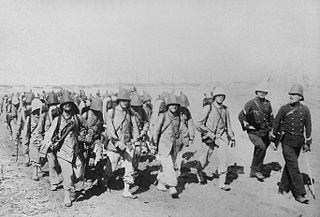
The Troupes coloniales or Armée coloniale, commonly called La Coloniale, were the colonial troops of the French colonial empire from 1900 until 1961. From 1822 to 1900 these troops were designated Troupes de marine, and in 1961 they readopted this name. They were recruited from mainland France or from the French settler and indigenous populations of the empire. This force played a substantial role in the conquest of the empire, in World War I, World War II, the First Indochina War and the Algerian War.
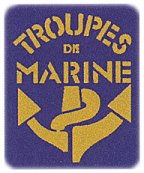
The Troupes de Marine is a corps of the French Army that includes several specialities: infantry, artillery, armoured, airborne, engineering, and transmissions (Signals). Despite its name, it forms part of the Army, not the Navy. Intended for amphibious and overseas operations, the Troupes de marine have been, and still are, in all the fights of the French army. It has gradually become professionalized since 1970.

The white poppy is a flower used as a symbol of peace, worn either in place of or in addition to the red remembrance poppy for Remembrance Day or Anzac Day.

A remembrance poppy is an artificial flower worn in some countries to commemorate their military personnel who died in war. Remembrance poppies are produced by veterans' associations, who exchange the poppies for charitable donations used to give financial, social and emotional support to members and veterans of the armed forces.
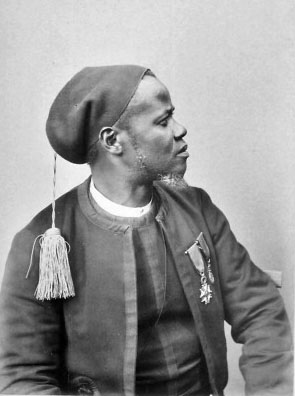
The Senegalese Tirailleurs were a corps of colonial infantry in the French Army. They were initially recruited from Senegal, French West Africa and subsequently throughout Western, Central and Eastern Africa: the main sub-Saharan regions of the French colonial empire. The noun tirailleur, which translates variously as 'skirmisher', 'rifleman', or 'sharpshooter', was a designation given by the French Army to indigenous infantry recruited in the various colonies and overseas possessions of the French Empire during the 19th and 20th centuries.

Joachim Napoléon Michel Murat, 6th Prince Murat, was a member of the Bonaparte-Murat family.

During World War I, France was one of the Triple Entente powers allied against the Central Powers. Although fighting occurred worldwide, the bulk of the French Army's operations occurred in Belgium, Luxembourg, France and Alsace-Lorraine along what came to be known as the Western Front, which consisted mainly of trench warfare. Specific operational, tactical, and strategic decisions by the high command on both sides of the conflict led to shifts in organizational capacity, as the French Army tried to respond to day-to-day fighting and long-term strategic and operational agendas. In particular, many problems caused the French high command to re-evaluate standard procedures, revise its command structures, re-equip the army, and to develop different tactical approaches.

The 4th Tunisian Tirailleurs Regiment was an infantry regiment of the Army of Africa, part of the French Army.

Albert Severin Roche (1895–1939) was a distinguished French soldier, known for his numerous successful missions and capturing of enemy soldiers throughout the First World War.
The National Office for Veterans and Victims of War is a French governmental agency under the Ministry of the Armed Forces. Its purpose is recognition and support of the nation's war veterans and victims, and directing national policy about war memorials and remembrances.

Madame E. Guérin was born at Vallon (-Pont-d’Arc), Ardèche, France. She was the originator of the Remembrance Poppy Day. Prior to this, she was a teacher in Madagascar; a lecturer for the Alliance Française; and a lecturer, fundraiser and humanitarian in the United States, during World War I. For services to France, she was awarded the Officier d'académie’ médaille and the Officier de l’Instruction Publique médaille. For her services to the United States, for the Liberty Bond, she was awarded the Victory Liberty Loan Medallion.





















